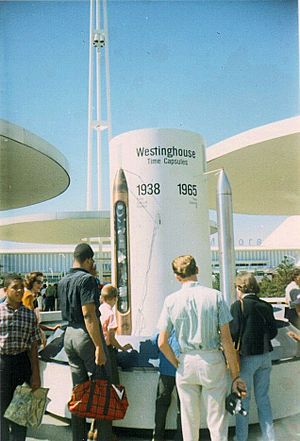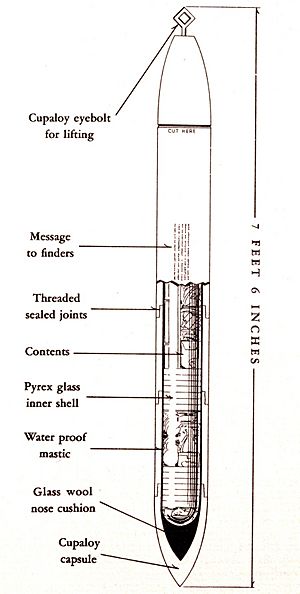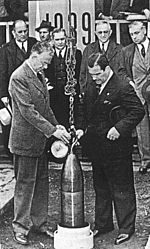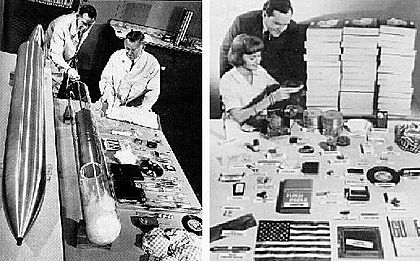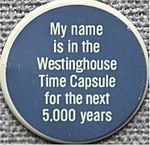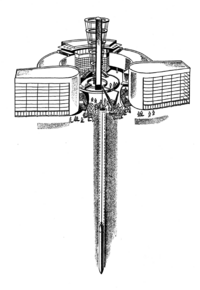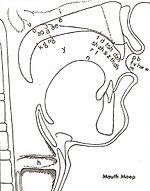Westinghouse Time Capsules facts for kids
The Westinghouse Time Capsules are two special containers made by the Westinghouse Electric Company. One was created in 1939 and the other in 1965. They are filled with everyday items and information from the 20th century in the United States. These capsules are meant to be opened by people living around the year 6900, so they can learn about our history.
The capsules are designed to last a very long time. They are made of special metals that won't rust or break down easily. Each capsule is about 90 inches long and 9 inches wide. They are buried 50 feet deep in the ground at Flushing Meadows–Corona Park in New York City, about ten feet apart.
Thousands of libraries, museums, and universities around the world received special books about these time capsules. These books explain that the capsules exist, where they are buried, and that they should not be opened before the year 6939. Copies of the items inside the capsules are also kept in a history museum in the United States.
Contents
What are the Westinghouse Time Capsules?
Westinghouse Electric & Manufacturing Company created these time capsules for two big events called World's Fairs. Both capsules are buried 50 feet deep under Flushing Meadows–Corona Park, which was the location of these fairs. The first capsule was made for the 1939 New York World's Fair, and the second one for the 1964 New York World's Fair. The second capsule is buried just ten feet north of the first one.
These capsules are packed with objects that show what life was like during those times, including things related to society and science. Both capsules are planned to be opened at the same time in the year 6939.
The idea for these time capsules came from a publicist named George Edward Pendray. In 1936, he learned about a similar project called the "Crypt of Civilization" at Oglethorpe University, which was also preserving items for the future. Westinghouse liked this idea and started making their first Time Capsule in 1938.
How Were the Time Capsules Built?
The time capsules look like bullets. They are about 90 inches (2.29 meters) long. Their outer shell is about 8.75 inches (22.2 cm) wide.
Time Capsule I weighs about 800 pounds (363 kg). It was made from a special metal alloy called Cupaloy, created just for this project. This alloy is mostly copper (99.4%), with a little chromium (0.5%) and silver (0.1%). Westinghouse designed Cupaloy to be as strong as steel but also able to resist rust for 5,000 years. It works by attracting rust deposits instead of breaking down itself.
Time Capsule II weighs about 400 pounds (181 kg). It was made from a different type of stainless steel called Kromarc. Scientists at Westinghouse tested Kromarc and found it would also resist rust for a very long time, similar to Cupaloy. Kromarc is a mix of iron, nickel, chromium, and other elements.
The items inside both capsules were sealed in an airtight glass container. This inner container was about 6.5 inches (16.5 cm) wide and 81 inches (206 cm) long. Capsule I was filled with nitrogen gas to protect its contents. Capsule II was filled with argon gas, another gas that doesn't react with other materials.
What's Inside the Capsules?
1939 Time Capsule I Contents
Time Capsule I holds 35 small, everyday items. These include a fountain pen and a set of alphabet blocks. It also has 75 different types of fabrics, metals, and plastics.
To save space, a lot of information was put on "Micro-File" microfilm. This includes modern books, art, and news from the 20th century. The Micro-File contains over ten million words and a thousand pictures. A small microscope is included to view them. There are also instructions on how to build larger viewers and movie projectors for the newsreels.
Other items in Capsule I are:
- Copies of Life magazine.
- A kewpie doll.
- One dollar in coins.
- A pack of Camel cigarettes.
- A 15-minute newsreel from RKO Pathe Pictures.
- A Lilly Daché hat.
- Microfilm rolls with a Sears Roebuck catalog, a dictionary, and an almanac.
Various seeds were also placed inside, like wheat, corn, oats, tobacco, cotton, rice, and carrots. These organic items were sealed in glass vials to protect them.
A man named George Edward Pendray oversaw the selection of items. Experts from the United States National Bureau of Standards checked each object to make sure it could last 5,000 years. They chose items that wouldn't react with each other or create harmful gases over time.
1965 Time Capsule II Contents
Time Capsule II focuses on five main types of objects:
- Everyday items.
- Things related to atomic energy.
- Scientific discoveries.
- Items about space.
- Other special items.
The "other" category includes pictures of a guest book. Visitors to the Westinghouse exhibit at the 1964 fair signed this book. People who signed received a small tin pin that said, My name is in the Westinghouse Time Capsule for the next 5,000 years. The pages of the guest book were photographed onto microfilm and placed in the capsule. About 750,000 people signed the book, including U.S. President Lyndon B. Johnson and Pope Paul VI.
The Book of Record
The items in Time Capsule I were listed in a book called Book of Record of the Time Capsule of Cupaloy. This book's main goal is to make sure people in the future know about the time capsule for 5,000 years. It also helps them find and dig up the capsule in the year 6939. More than 3,000 copies of this book were sent to museums, monasteries, and libraries worldwide. When the 1965 capsule was made, a new message was sent to these places to let them know about the second capsule too.
The book also includes astronomical information. This is in case future generations lose track of how we measure time. They can use the positions of the moon, sun, and planets from 1939 to figure out how many years have passed since the capsule was buried.
Where Are the Time Capsules Buried?
Time Capsule I was buried at noon on September 23, 1938. This was the exact moment of the Autumnal Equinox (when day and night are equal length). The exact location was recorded in the Book of Record using latitude and longitude coordinates.
Since the ground might shift over thousands of years, an extra way to find the capsules was provided. This method involves using an electromagnetic field. By creating a large loop of wire and sending an electric current through it, future people can detect a "distortion field" caused by the metal capsules. This will help them find the exact spot, as long as there aren't other big metal objects nearby.
After the 1965 World's Fair ended, a huge 7-ton granite monument was placed over the burial site. This monument marks the spot where the two time capsules are buried. The area around the capsules was filled with pitch, concrete, and earth to protect them.
The burial site is about 7 feet above sea level. Some experts think that in 5,000 years, this area might be underwater due to global climate change.
Messages for the Future
The Book of Record contains special messages from three important people of that time. A copy of these messages was also put on microfilm inside Time Capsule I.
Albert Einstein's message:
Our time has many smart people who invent things that make life easier. We travel across oceans and use power to avoid hard work. We can fly and send messages around the world with electricity. But, how we make and share goods is messy, so people worry about losing their jobs and not having enough. Also, people in different countries fight each other often, which makes thinking about the future scary. This is because most people aren't as smart or kind as the few who create good things for everyone. I hope people in the future will read this and feel proud and much better than us.
Robert Andrews Millikan's message:
Right now, in 1938, governments where people vote, like in English, French, and Scandinavian countries, are strongly fighting against governments where one person has all the power. For most of history, one person has controlled everyone. If fair, scientific, and forward-thinking ideas win this fight, humanity could have a peaceful, golden age. If the old ways of one-person rule win, then human history will just repeat the sad stories of war and unfairness.
Thomas Mann's message:
We now know that thinking the future would be a "better world" was a mistake. Our hopes for you, citizens of the future, are not too high. You will actually be very much like us, just as we are like people from a thousand or five thousand years ago. The spirit of learning and creating will also have a tough time among you. It shouldn't be too easy on Earth, or people wouldn't need it anymore. What we call "culture" today is simply this effort to become more like our ideal selves, to make humanity more human. What we call "spirit" is the same thing. Brothers and sisters of the future, connected with us in spirit and this effort, we send our greetings.
The phrase "time capsule" was actually created by George Edward Pendray for the 1939 World's Fair Westinghouse exhibit.
Message on the Time Capsules
The outside of the 1938 time capsule has a special message stamped into it. This message is for anyone who might find it before the planned opening year of 6939.
TIME CAPSULE OF CUPALOY, DEPOSITED ON THE SITE OF THE NEW YORK WORLD'S FAIR ON SEPTEMBER 23,1938,
BY THE WESTINGHOUSE ELECTRIC & MANUFACTURING COMPANY. IF ANYONE SHOULD COME UPON THIS CAPSULE
BEFORE THE YEAR A. D. 6939 LET HIM NOT WANTONLY DISTURB IT, FOR TO DO SO WOULD BE TO DEPRIVE THE
PEOPLE OF THAT ERA OF THE LEGACY HERE LEFT THEM. CHERISH IT THEREFORE IN A SAFE PLACE.
The 1965 time capsule does not have a message on its outside. An exact copy of the items from the 1965 capsule is kept at the Heinz History Center, along with a copy of the 1939 capsule.
How to Understand Old English
The Book of Record asks that its contents be translated into new languages as they develop over time. It also includes a special guide with pictures, created by Dr. John P. Harrington from the Smithsonian Institution. This guide is meant to help future archaeologists understand the English language of 1938, in case it changes a lot or is forgotten.
The guide even has a "mouth map" that shows exactly how each of the 33 sounds of 1938 English were made in the mouth.
See also
 In Spanish: Cápsulas del Tiempo Westinghouse para niños
In Spanish: Cápsulas del Tiempo Westinghouse para niños


